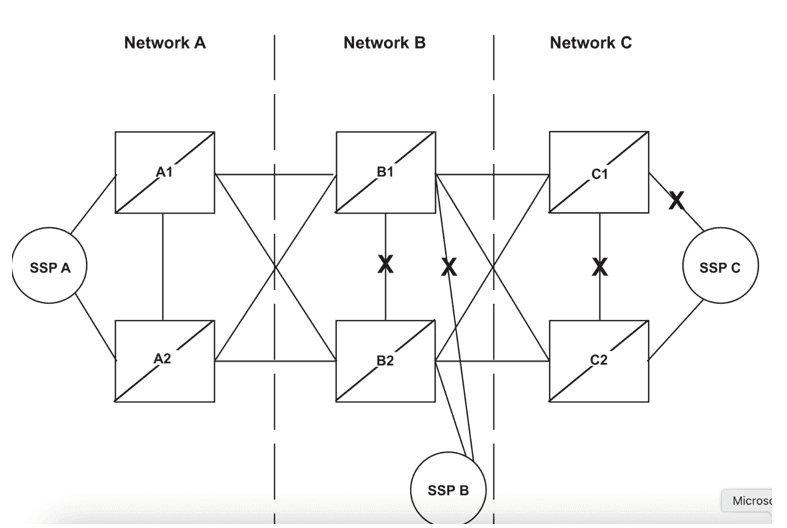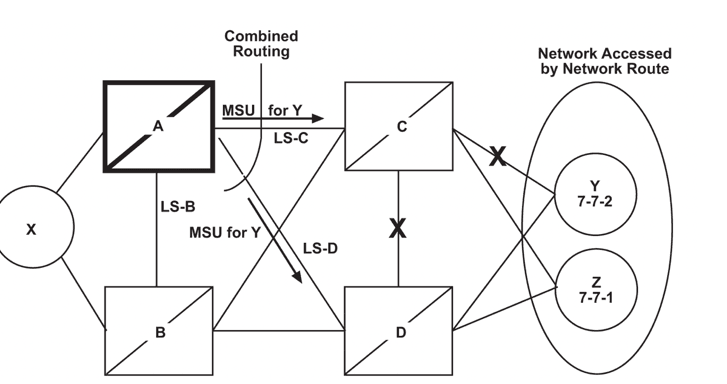2.34 Network Routing
Network Routing allows the user to provision a single routeset which can be used for all MSUs destined to members of that specific network.
Network Routing Advantages:
- Reduces the number of entries in the route table.
- Enables routing to members of a network without having to add those members to the route table.
Note:
Network Routing can be used only with ANSI point codes. A Network Routing point code cannot be provisioned as a proxy point code.Routing Strategy Types
vSTP currently supports three routing strategy types:
- Full point code routing.
- Cluster Routing
- Network Routing.
Network Routing allows the user to provision a third type of routing strategy. It is possible to provision full point code entries, cluster entries, and network entries for members of the same network. Any overlaps in the routing strategies are handled by a specific searching hierarchy.
The following route table entries can coexist:
- 8-1-1 – Full point code entry
- 8-1-* – Cluster entry
- 8-*-* – Network entry
The searching hierarchy tries to match against a full point code entry first, followed by a cluster entry, and finally a network entry. In the following example:
when the vSTP routes an MSU destined for 8-1-1, it uses the full point code entry.
when the vSTP routes an MSU destined for 8-1-2 it uses the cluster entry.
when the vSTP routes an MSU destined for 8-2-2, it uses the network entry.
Applications
Network routing is beneficial when the destination node is distant from the source node. The reliability of network routing increases when the destination is further away. In the below illustration, routing from network A is more reliable to nodes in network C than to nodes in network B.
Figure 2-52 Applications

If the nodes in network A use network routing for network C, network A can still route traffic to SSP C, even if two linksets fail. In this example, one of the linksets to SSP C and the linkset between node C1 and node C2 fail. In this case, the vSTP in network A continues to route half of its traffic to node B1, and half to node B2. Node B1 and node B2 (which do not use network routing) route all traffic to SSP C through node C2.
If the nodes in network A use network routing for network B, traffic routed to SSP B may be lost if two linksets fail. In this example, one of the linksets to SSP B and the linkset between node B1 and node B2 fail. In this case, the vSTP in network A continues to route half of its traffic to node B1, and half to node B2. Traffic for SSP B routed through node B1 is discarded, resulting in message loss.
Route Availability
A route is one path to a destination. A routeset is a list of paths to a destination. Route availability consists of two parts:
- Local availability
- Remote availability
Remote availability is affected by TFx network management messages. Local availability is affected by linkset failures and recoveries. TFx messages do not affect point codes accessed by network route entries. Therefore, for network route entries, route availability consists of only local availability. The highest priority linkset available for traffic is used for routing MSUs, regardless of the remote availability of that route.
Figure 2-53 Route Availability

In the above illustration, linksets LS-C and LS-D form a combined route to network route 7-*-*. It is because 7-*-* is a network route, the vSTP always considers the non-adjacent status of the routes to be allowed. In the example shown, the vSTP routes traffic destined to 7-7-1 over LS-C and LS-D. The vSTP ignores TFPs concerning 7-7-1 or TCPs concerning 7-7-*.
Point Code Availability
A point code that is accessed by a network route entry is considered available if there is any linkset in the routeset that is available for traffic.
Local Link Congestion
This feature has no impact on the generation of TFC messages. A is generated concerning point code X-Y-Z, even if X-Y-Z is routed using a network route entry.
Remote Congestion
Since the vSTP has global title capabilities, it is possible for the vSTP to receive a TFC concerning a point code that is accessed by a network route entry. Network route entries are not affected by TFC messages.
Broadcast Transfer Messages
The vSTP does not broadcast TFx messages for network route entries.
Response Method Transfer Messages
The vSTP sends response method TFx messages for network routes as follows:
- Prohibited Network Routes: If the vSTP receives an MSU that is
accessed by a network route entry, and that network route is Prohibited, the
vSTP sends a response method TFP or TCP message, as follows:
- If there is a Full Point Code defined in the same cluster as the MSU (for example, 8-*-* and 8-1-1 are defined in the vSTP routing table, and MSU is destined for 8-1-2), the vSTP sends a TFP with concerned point code set to the vSTP’s DPC.
- Otherwise, the vSTP sends a TCP with concerned point
code set to the cluster of the MSU's DPC.
The vSTP sends response method TCPs or TFPs at a rate of one TCP or TFP during the T8 timer period for each network route.
For example, in the above Applications illustration, the network route for 7-*-* becomes Prohibited due to the failure of LS-B, LS-C, and LS-D. When the vSTP receives an MSU from X destined for 7-7-1, the vSTP sends a response method TCP concerning 7-7-*. When the vSTP receives an MSU from X destined for 7-8-2, the vSTP sends a response method TCP concerning 7-8-*.
- System Detects Danger of Circular Routing
If the vSTP receives an MSU that is accessed by a network route entry, and the vSTP detects danger of circular routing, the vSTP sends a response method TFP or TCP message, as follows:
- If there is a Full Point Code defined in the same cluster as the MSU (for example, 8-*-* and 8-1-1 are defined in the vSTP routing table, and the MSU is destined for 8-1-2), the vSTP sends a TFP with concerned point code set to the MSU's DPC.
- Otherwise, the vSTP sends a TCP with concerned point code set to the cluster of the MSU's DPC.
The vSTP sends response method TCPs at a rate of one TCP during T8 timer period for each network route.
For example, in Applications illustration, all linksets are available. If the vSTP receives an MSU from node C destined for 7-7-1, the vSTP detects danger of circular routing, and sends a response method TCP concerning 7-7-*. The vSTP also discards the MSU.
- Restricted Network Routes
If the vSTP receives an MSU that is accessed by a network route entry, and that network route is Restricted, the vSTP sends a response method TFR or TCR message, as follows:
- If there is a Full Point Code defined in the same cluster as the MSU (for example, 8-*-* and 8-1-1 are defined in the vSTP routing table, and MSU is destined for 8-1-2), the vSTP sends a TFR with concerned point code set to the MSUs DPC.
- Otherwise, the vSTP sends a TCR with concerned point code set to the cluster of the MSUs DPC.
For example, in the Applications illustration , the network route for 7-*-* becomes Restricted and there is failure of LS-C and LS-D. When the vSTP receives an MSU from X destined for 7-7-1, the vSTP sends a response method TCR concerning 7-7-*, then routes the MSU over LS-B. When the vSTP next receives an MSU from X destined for 7-8-2, the vSTP does not send a response, and routes the MSU over LS-B.
Reception of an RSx Message
Note:
The searching hierarchy applies.Table 2-55 Reception of an RSx Message
| Concerned Point Code is: | Result |
|---|---|
| Found by a Full Point Code match | No change to existing rules. |
| Found by a cluster match | No change to existing rules. |
| Found by a network match | Send a TFx message based on the current routeset
status.
Otherwise:
|
| Not found | No change to existing rules. Send a TFP. |
Reception of an RCX Message
Note:
The searching hierarchy applies.Table 2-56 Reception of an RCx Message
| Concerned Point Code is: | Result |
|---|---|
| Found by a cluster match | No change to existing rules. |
| Found by a network match |
Send a TCx message based on the current routeset status.
Otherwise:
|
| Not found | No change to existing rules. Send a TCP. |